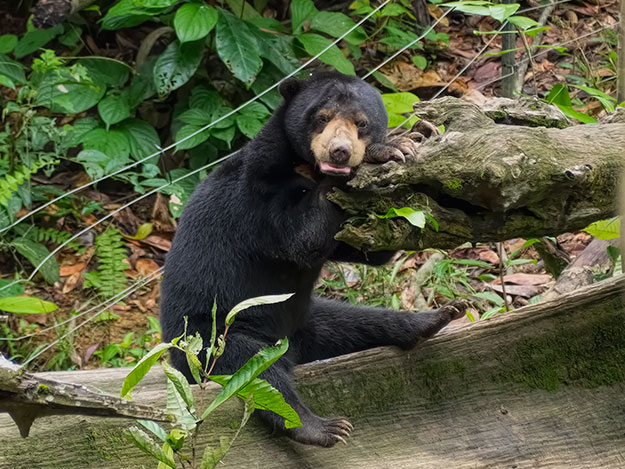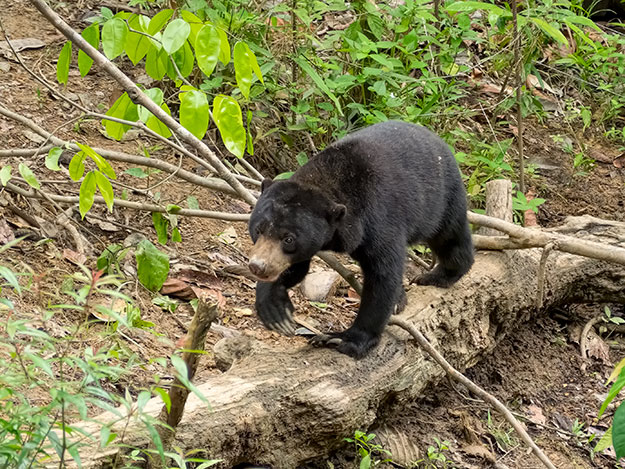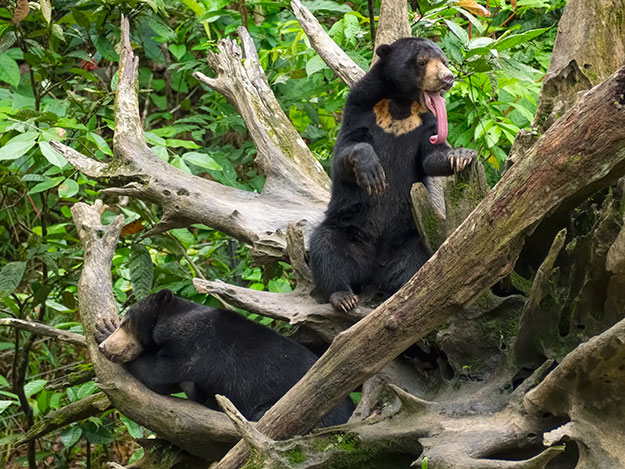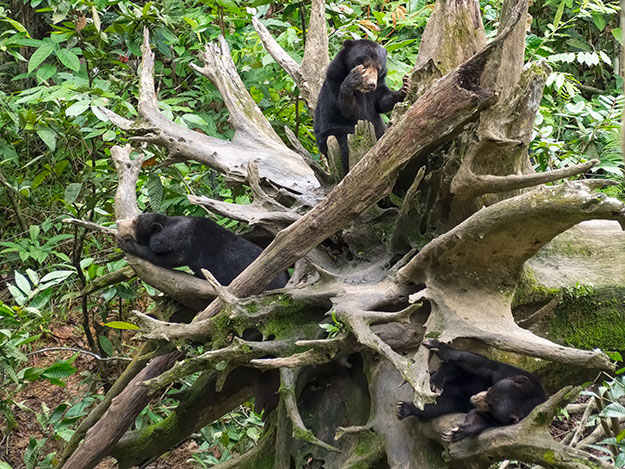At high noon, I stood on the viewing platform at the Bornean Sun Bear Conservation Center in Sabah, Borneo. In the intense humidity, rivers of sweat streamed down my face and neck. Within minutes, my T-shirt was soaking wet. I peered down into the enclosures below expecting these smallest of all the bear species to be sleeping or at best lethargic, but to my surprise they were active. Borneo is in the tropics, where it is always steamy. These bears are not bothered by the heat and humidity. I envied them.

Behind me, a man I assumed to be a tour guide was providing information about the Sun Bears. He looked strangely familiar. Suddenly, I realized his photo was splashed across a sign at the entrance to the Bornean Sun Bear Conservation Center. He was the Honorable Dr. Wong Siew Te, CEO and Founder of the facility. I waited until the crowd had dispersed to wrangle him for an interview. The more we talked, the more I had a sense of having spoken to him previously. “I think I saw a documentary about your work,” I said. He smiled. “I was chosen as a CNN Hero in 2017,” he replied, “so maybe that’s how you know me.”

Of course! In preparation for their 2018 event, CNN had recently been rerunning features about previous year’s nominees. The program about Dr. Siew Te was one of the features I watched. Born in Penang, Malaysia, Siew Te attended university in Missoula, Montana. His 1994 undergraduate studies were in veterinary science, but fate intervened when he met a scientist looking for someone to research the Sun Bears of Borneo. Until that propitious meeting, he hadn’t heard of Sun Bears but, being from Malaysia, he was immediately intrigued.
Dr. Siew Te switched his major and pursued his masters in wildlife biology. After graduation in 2004, he returned to Borneo and began studying Sun Bears. While conducting a survey of their numbers across Malaysia, he discovered that local hunters were poaching the adult bears for their meat. Often, they would take orphaned cubs home as pets. Logging was at its peak in those days and the destruction of their habitat was creating additional pressure. “I saw a need not only to protect the Sun Bears, but also to give them a home,” Siew Te said.

In 2008, he learned about the Sepilok Orangutan Rehabilitation Center in on the Malaysian portion of the island of Borneo. He approached the government with a proposal to set aside a large parcel of land adjacent to the Sepilok Orangutan Rehabilitation Center, where the Sun Bears could have a safe and secure home. The Sabah Wildlife Department donated half of the required land and the Forestry Department agreed to lease the rest to him for 10,000 MYR per year. The Bornean Sun Bear Conservation Center was born.
Today, the center is home to 45 bears, all of whom were rescued from situations where they were being kept as pets. Rather than spending a lifetime in cramped wooden crates, the rescued bears now live in spacious open-air enclosures at the conservation center. “We have 10 enclosures, but only three are open to the public,” he explained.

Thousands of people pass through the center each year to view the antics of the bears. Using their long claws, they rip through logs and dig in the dirt searching for ants, termites, centipedes, millipedes, and beetle grubs. They eagerly lap up any invertebrates they find with a long narrow tongue that curls upward at the tip. It’s the perfect tool for scooping creepy-crawlies out of hard-to-reach crevices.
Honey is another favorite food. Their keen sense of smell allows them to locate honey inside of trees, earning them the nickname Honey Bears among locals. No one is quite sure how they came to be officially called Sun Bears, though some claim the semi-circular blaze on their chest has something to do with it. I was fortunate enough to see one rise up on its hind legs and display the gold and orange marking that resembles a blazing sun. I have little doubt it’s the source of their name.

Though the Bornean Sun Bear Conservation Center has done much to ensure the survival of this endangered species, many challenges remain. “It’s not cheap to take care of 45 bears. It costs 15,000 MYR to feed one bear for one year,” Dr. Siew Te explained. The 30 MYR entrance fee only goes so far, thus fundraising is a necessity. Visitors are encouraged to host a party, run a marathon, or bake cookies to benefit the Sun Bears. The center also offers the opportunity to support individuals through an adoption program. Those who do so receive regular updates about their adopted bear. Of course, donations are always welcome and every penny received is used to care for the bears. There’s even a volunteer program available for those who wants to get hands-on experience in caring for the Sun Bears of Borneo.
I was walking on air by the time I left. I’d come to Borneo with the specific intention of seeing orangutans in the wild, but the Sun Bears were equally impressive. Borneo is truly a wonderland for nature lovers.

Sun Bears are so cute, thank you for your blog let me know more about them!! Meanwhile, I feel
although these animals look huge, they need our help.
You’re welcome Yuan.
Fabulous article, Barbara…can’t wait to experience the beauty of these animals in their habitat…omw now for a few days!
Can’t wait to hear about your trip, Crystal!
How incredibly cute and what a thrill Barbara! I can see why CNN honored this man. What a fabulous purpose.
And if you think the Sun Bears are cute, wait till you read my story about the Proboscis monkeys!